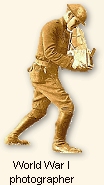|
The photographic documentation of war began soon after the camera's invention.
In 1855, Englishman Roger Fenton packed a wagon with photographic equipment and set out to cover the Crimean War. Although precedent-setting, his carefully posed images of British camp life failed to capture the drama and horror of war - no dead bodies, no mass destruction. This was in part due to the handicaps of his equipment and to the goal of his royal patrons to portray the war in the best light possible.
A few years later, the photographers of the American Civil War hauled their bulky equipment onto the battlefield to capture war's grisly aftermath. Their images - fields filled with the bloating bodies of the dead - caused a public sensation. Their groundbreaking efforts however, can be more appropriately described as battlefield rather than combat photography. The technical limitations of their equipment prevented them from catching the action of war.
 Armed with faster film, smaller cameras and no longer needing to haul a darkroom
behind him, the World War I photographer could get closer to combat. The introduction
of 35mm film increased the intimacy of the camera's eye, enabling the World
War II photographer to become part of the action. Television changed perspectives
again - the war in Vietnam literally entered the living rooms of millions of
Americans each night. Today, with the introduction of satellite connections,
our images of war are not only in our living room but they are instantaneous
and live. Armed with faster film, smaller cameras and no longer needing to haul a darkroom
behind him, the World War I photographer could get closer to combat. The introduction
of 35mm film increased the intimacy of the camera's eye, enabling the World
War II photographer to become part of the action. Television changed perspectives
again - the war in Vietnam literally entered the living rooms of millions of
Americans each night. Today, with the introduction of satellite connections,
our images of war are not only in our living room but they are instantaneous
and live.
Although the camera has changed our impression of war, the reality of war remains the same. As the Marine to the left wearily clamors over the ship's guardrail, his expression reveals the horrors that have been war's companion since the beginning of time.
How To Cite This Article:
"Combat Photography, 1918-1971," EyeWitness to History, www.eyewitnesstohistory.com (2000).
|






